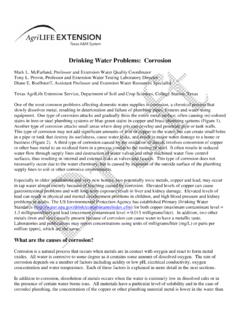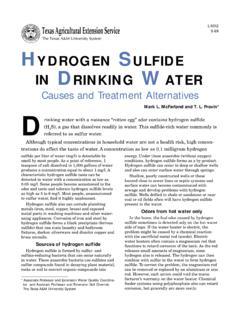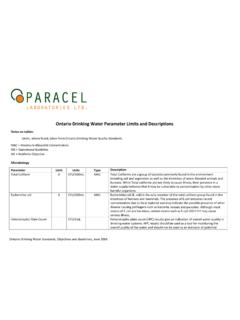Transcription of Water Quality Data Table - La Mesa Water Cooperative
1 La Mesa Water Cooperative Box 53 Placitas, NM 87043 2008 Annual drinking Water Quality Report We're pleased to present to you this year's Annual Water Quality Report (also known as the Consumer Confidence Report). This report is designed to inform you about the Quality Water and services we deliver to you every day. Our constant goal is to provide all of us with a safe and dependable supply of drinking Water . We have four wells that draw from the Rio Grande Basin-Fill, which underlies La Mesa and Sundance subdivisions, at depths to Water of 225 to 300 feet. We're pleased to report that our drinking Water is safe and meets federal and state requirements. If you have any questions about this report please write to La Mesa Water Cooperative , Box 53 Placitas, NM 87043.
2 We want our members to be informed about their Water utility. If you want to learn more, please attend any of our regularly scheduled meetings. They are usually held on the 4th Tuesday of each month at the co-op s office on 104 Camino Barranca. Meeting notices are posted in advance of each meeting at the mail boxes. Mesa Water Cooperative routinely monitors for constituents in your drinking Water according to federal and state laws. The enclosed Table shows the most recent results of monitoring. The New Mexico Environment Department (NMED) conducts well testing and tests each well every three years for organic and inorganic contaminants. Testing for contaminants is done on a schedule set by NMED.
3 Tests are conducted for Coliform bacteria on a monthly basis and all of our results have been negative. Radio-nuclides testing is done every five years. You will be promptly notified if NMED notifies us of any violations. Water Quality Data Table The Table below lists all of the drinking Water contaminants that we detected during the calendar year of this report. The presence of contaminants in the Water does not necessarily indicate that the Water poses a health risk. Unless otherwise noted, the data presented in this Table is from testing done in the calendar year of the report. The EPA or the State requires us to monitor for certain contaminants less than once per year because the concentrations of these contaminants do not change frequently.
4 MCLG MCL, or TT, or Your Range Sample Contaminants MRDLGMRDL Water Low High Date Violation Typical Source Inorganic Contaminants Nitrate [measured as Nitrogen] (ppm) 10 10 -- 2008 No Runoff from fertilizer use; Leaching from septic tanks, sewage; Erosion of natural deposits Fluoride (ppm) 4 4 _ 2008 No Erosion of natural deposits; Discharge from fertilizer Antimony(mg/L) Arsenic (mg/L) Barium (mg/L) < < -- -- -- -- -- -- 2008 2008 2008 No No No Erosion of natural deposits; Runoff from orchards Erosion of natural deposits Discharge of drilling wastes Erosion of natural deposits Page 2 Beryllium (mg/L) Cadmium (mg/L) Chromium (mg/L) Mercury (mg/L) Nickel (mg/L) Selenium (mg/L) Thallium (mg/L) < < < <.
5 0002 < < < -- -- -- -- -- -- -- -- -- -- -- -- -- -- 2008 2008 2008 2008 2008 2008 2008 No No No No No No No Erosion of natural deposits Erosion of natural deposits Erosion of natural deposits Erosion of natural deposits Erosion of natural deposits Erosion of natural deposits Erosion of natural deposits Radioactive Contaminants Uranium ( g/L) 0 30 2005 No Erosion of natural deposits Volatile Organic Contaminants TTHMs [Total Trihalomethanes] (ppb) NA 80 NA 2008 No By-product of drinking Water disinfection Disinfectants & Disinfection By-Products Chlorine (ppm) 4 4 2008 No Water additive used to control microbes Your Sample # Samples Exceeds Contaminants MCLG AL Water Date Exceeding AL AL Typical Source Inorganic Contaminants Copper - action level at consumer taps (ppm).
6 23 2005 0 No Corrosion of household plumbing systems; Erosion of natural deposits Unit Descriptions Term Definition ppm ppm: parts per million, or milligrams per liter (mg/L) ppb ppb: parts per billion, or micrograms per liter ( g/L) pCi/L pCi/L: picocuries per liter (a measure of radioactivity) NA NA: not applicable ND ND: Not detected NR NR.
7 Monitoring not required, but recommended. Important drinking Water Definitions Term Definition MCLG MCLG: Maximum Contaminant Level Goal: The level of a contaminant in drinking Water below which there is no known or expected risk to health. MCLGs allow for a margin of safety. MCL MCL: Maximum Contaminant Level: The highest level of a contaminant that is allowed in drinking Water . MCLs are set as close to the MCLGs as feasible using the best available treatment technology. TT TT: Treatment Technique: A required process intended to reduce the level of a contaminant in drinking Water . AL AL: Action Level: The concentration of a contaminant which, if exceeded, triggers treatment or other requirements which a Water system must follow.
8 Variance and Exemptions Variances and Exemptions: State or EPA permission not to meet an MCL or a treatment technique under certain conditions. MRDLG MRDLG: Maximum residual disinfection level goal. The level of a drinking Water disinfectant below which there is no known or expected risk to health. MRDLGs do not reflect the benefits of the use of disinfectants to control Page 3 microbial contaminants. MRDL MRDL: Maximum residual disinfectant level. The highest level of a disinfectant allowed in drinking Water .
9 There is convincing evidence that addition of a disinfectant is necessary for control of microbial contaminants. MNR MNR: Monitored Not Regulated MPL MPL: State Assigned Maximum Permissible Level Arsenic is a naturally occurring mineral known to cause cancer in humans at high concentrations. Some people who drink Water -containing arsenic significantly in excess of the regulatory standard over many years could experience skin damage or problems with their circulatory system, and may have an increased risk of getting cancer. As of January 23, 2006 the Environmental Protection Agency (EPA) has imposed a more stringent standard of 10 ppb (parts per billion) compared to the previous standard of 50 ppb.
10 In 2006 La Mesa Water Cooperative began the process of addressing arsenic abatement, primarily because Well #3's arsenic level is 22 ppb - below the old standard, but non-compliant with the new one, so this well is no longer in use. Your Board considered a number of approaches to address this matter and decided to drill a new well in an area where the Water is compliant with the standard. A new well, Well #5 has been drilled on the La Mesa Park site on 5 Calle Cienega and is presently on-line supply Water with an arsenic level well below the new 10 ppb Your Board is studying additional alternatives such as refurbishing Well #1which began to show some unanticipated problems in 2007. This work is now done.





